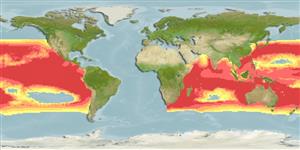Classificação / Names
Common names from other countries
Referência principal
Tamanho / Peso / Idade
Max length : 230 cm TL macho/indeterminado; (Ref. 9308); common length : 190 cm TL macho/indeterminado; (Ref. 9308); Peso máx. publicado: 52.0 kg (Ref. 43)
Ambiente
; marinhas; oceanódromo (Ref. 51243); intervalo de profundidade 0 - 1830 m (Ref. 86942), usually 0 - 350 m (Ref. 89423)
Clima / Intervalo
Subtropical, preferred 28°C (Ref. 107945); 43°N - 56°S, 20°E - 68°W
Distribuição
Indian and Pacific: tropical and temperate waters. Although some stray individuals are found in the Atlantic Ocean, this species is believed to have its spawning grounds and principal populations only in the Pacific and Indian Oceans. Highly migratory species, Annex I of the 1982 Convention on the Law of the Sea (Ref. 26139).
Países | Áreas FAO | Ecossistemas | Ocorrências | Introduções
Descrição breve
Espinhos dorsais (total): 0; Raios dorsais moles (total): 51-57; Espinhos anais 0; Raios anais moles: 18 - 23. Dark blue above, blue splattered with brown on the sides, silvery white below; 1st dorsal fin plain dark blue, other fins brown or dark brown; anal fin bases with tinges of silvery white.
Categoria na Lista Vermelha da IUCN (Ref. 115185)
Ameaça para o homem
Harmless
Utilização humana
Pescarias: pouco comercial; peixe desportivo: sim
Mais informação
ReferênciasAquaculturaPerfil para aquaculturaEstirpesGenéticaFrequência dos alelosHereditariedadeDoençasProcessamentoMass conversion
Ferramentas
Relatórios especiais
Descarregue XML
Fontes da internet
Estimates of some properties based on models
Phylogenetic diversity index
PD50 = 0.5630 many relatives (e.g. carps) 0.5 - 2.0 few relatives (e.g. lungfishes)
Nível Trófico
4.5 ±0.76 se; Based on food items.
Resiliência
Médio, tempo mínimo de duplicação da população 1,4 - 4,4 anos (Assuming tm=2-4)
Vulnerabilidade
Moderate vulnerability (42 of 100)
Categoria de preço
